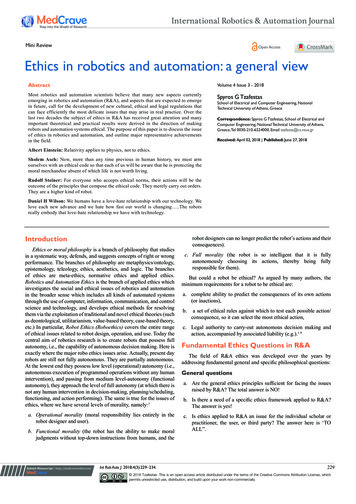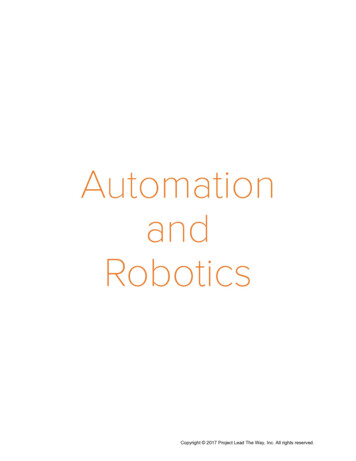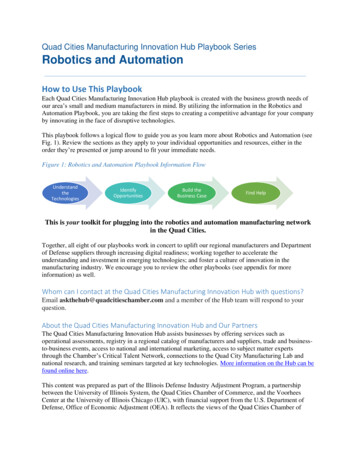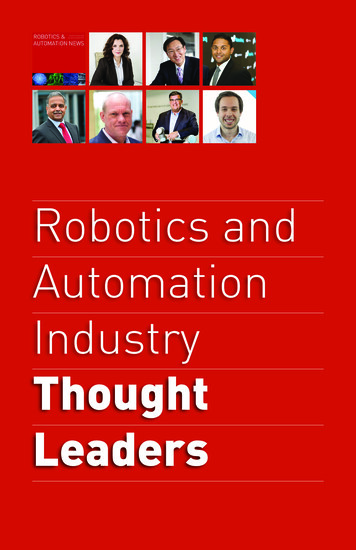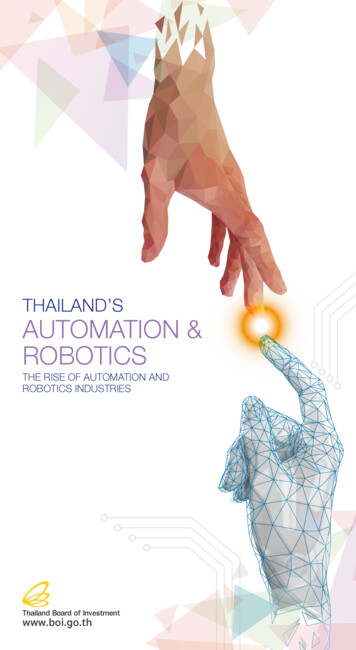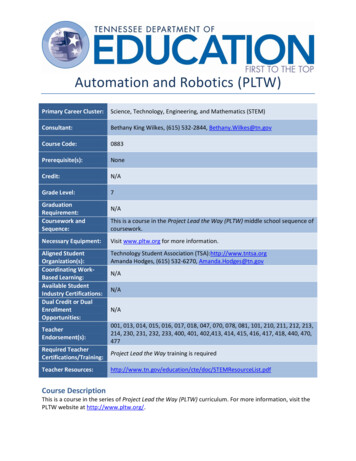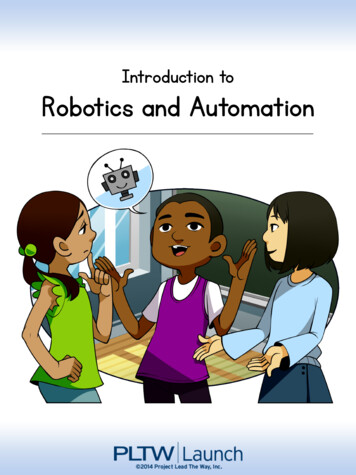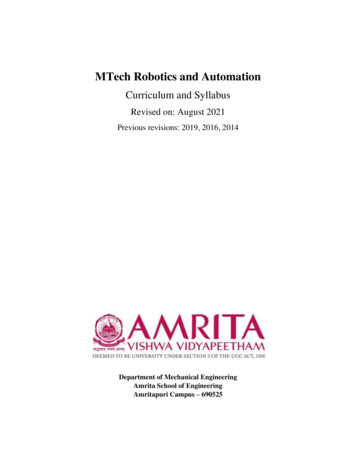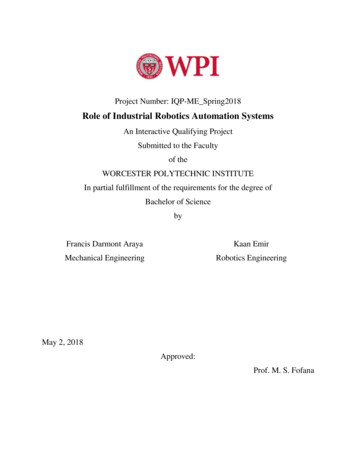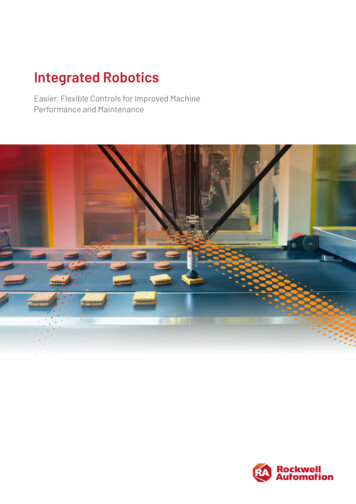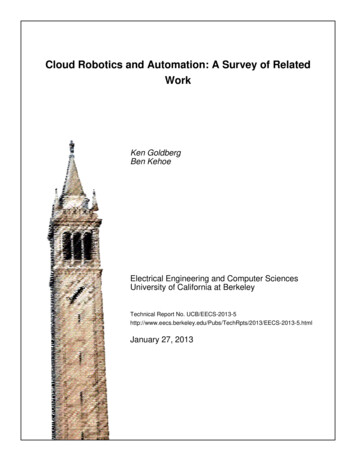
Transcription
Cloud Robotics and Automation: A Survey of RelatedWorkKen GoldbergBen KehoeElectrical Engineering and Computer SciencesUniversity of California at BerkeleyTechnical Report No. echRpts/2013/EECS-2013-5.htmlJanuary 27, 2013
Copyright 2013, by the author(s).All rights reserved.Permission to make digital or hard copies of all or part of this work forpersonal or classroom use is granted without fee provided that copies arenot made or distributed for profit or commercial advantage and that copiesbear this notice and the full citation on the first page. To copy otherwise, torepublish, to post on servers or to redistribute to lists, requires prior specificpermission.AcknowledgementThe authors thank James Kuffner, Steve Cousins, Rafaello D'Andrea, AlexWaibel, Gary Bradski, Vijay Kumar, Erico Guizzo, Dmitry Berenson, andPieter Abbeel for ongoing insights and advice on this topic. This work wassupported in part by NSF Award IIS-1227406.ContactKen Goldberg, craigslist Distinguished Professor of New MediaProfessor, IEOR and EECS, College of Engineering, UC BerkeleyDept of Art Practice and School of Information, UC BerkeleyProfessor, Department of Radiation Oncology, UC San Francisco
Contact: 425 Sutardja Dai Hall, Berkeley, CA 94720-1758twitter: @Ken Goldberg g : http://j.mp/Ken Goldberg(510) 643-9565 goldberg@berkeley.edu http://goldberg.berkeley.edu
1Cloud Robotics and AutomationWhat if robots and automation systems were not limited by onboard computation, memory, or programming?This is now practical with wireless networking and rapidly expanding Internet resources. In 2010, JamesKuffner at Google introduced the term “Cloud Robotics” [54] to describe a new approach to robotics thattakes advantage of the Internet as a resource for massively parallel computation and real-time sharingof vast data resources. The Google autonomous driving project exemplifies this approach: the systemindexes maps and images that are collected and updated by satellite, Streetview, and crowdsourcing fromthe network to facilitate accurate localization. Another example is Kiva Systems new approach to warehouseautomation and logistics using large numbers of mobile platforms to move pallets using a local network tocoordinate planforms and update tracking data. These are just two new projects that build on resourcesfrom the Cloud. Steve Cousins of Willow Garage aptly summarized the idea: “No robot is an island.” CloudRobotics recognizes the wide availability of networking, incorporates elements of open-source, open-access,and crowdsourcing to greatly extend earlier concepts of “Online Robots” [36] and “Networked Robots”[35, 56].Figure 1: A cloud robot system that incorporates Amazon’s Mechanical Turk to “crowdsource” objectidentification to facilitate robot grasping [68]. (Image reproduced with permission from authors).The Cloud has been used as a metaphor for the Internet since the inception of the World Wide Web inthe early 1990’s. As of 2012, researchers are pursuing a number of cloud robotics and automation projects[39] [70] . New resources range from software architectures [19] [30] [42] [48] to computing resources [44].The RoboEarth project [74] aims to develop “a World Wide Web for robots: a giant network and databaserepository where robots can share information and learn from each other about their behavior and theirenvironment” [15]. Cloud Robotics and Automation is related to concepts of the “Internet of Things” [20]and the “Industrial Internet,” which envision how RFID and inexpensive processors can be incorporatedinto a vast array of objects from inventory items to household appliances to allow them to communicate andshare information.This report reviews five ways that Cloud Robotics and Automation has potential to improve performance:1) providing access to global libraries of images, maps, and object data, eventually annotated with geometryand mechanical properties, 2) massively-parallel computation on demand for demanding tasks like optimal motion planning and sample-based statistical modeling, 3) robot sharing of outcomes, trajectories, anddynamic control policies, 4) human sharing of “open-source” code, data, and designs for programming, experimentation, and hardware construction, and 5) on-demand human guidance (“call centers”) for exceptionhandling and error recovery.Updated information and links are available at: http://goldberg.berkeley.edu/cloud-robotics/1
1.1Big DataThe term “Big Data” describes data sets that are beyond the capabilities of standard relational databasesystems, which describes the growing library of images, maps, and many other forms of data relevant torobotics and automation on the Internet. One example is grasping, where online datasets can be consultedto determine appropriate grasps. The Columbia Grasp dataset [37] and the MIT KIT object dataset [49]are available online and have been widely used to evaluate grasping algorithms [28] [27] [76] [64].Related work explores how computer vision can be used with Cloud resources to incrementally learngrasp strategies [24] [59] by matching sensor data against 3D CAD models in an online database. Examplesof sensor data include 2D image features [43], 3D features [38], and 3D point clouds [23]. Google Goggles[7], a free network-based image recognition service for mobile devices, has been incorporated into a systemfor robot grasping [50] as illustrated in Figure 2.Dalibard et al. attach “manuals” of manipulation tasks to objects [26]. The RoboEarch project storesdata related to objects maps, and tasks, for applications ranging from object recognition to mobile navigationto grasping and manipulation (see Figure 5) [74].As noted below, online datasets are effectively used to facilitate learning in computer vision. By leveragingGoogle’s 3D warehouse, [55] reduced the need for manually labeled training data. Using community photocollections, [31] created an augmented reality application with processing in the cloud.CloudGoogleObject RecognitionEngine3D CADModelImageRobotsCameraGoogleCloud StorageObject Label3D SensorPoint sultsSelect FeasibleGrasp withHighest SuccessProbabilityFigure 2: System Architecture for cloud-based object recognition for grasping. The robot captures an imageof an object and sends via the network to the Google object recognition server. The server processes theimage and returns data for a set of candidate objects, each with pre-computed grasping options. The robotcompares the returned CAD models with the detected point cloud to refine identification and to performpose estimation, and selects an appropriate grasp. After the grasp is executed, data on the outcome is usedto update models in the cloud for future reference [50]. (Image reproduced with permission from authors).1.2Cloud ComputingAs of 2012, Cloud Computing services like Amazon’s EC2 elastic computing engine provide massively-parallelcomputation on demand [18]. Examples include Amazon Web Services [2] Elastic Compute Cloud, known asEC2 [1], Google Compute Engine [6], Microsoft Azure [8]. These rovide a large pool of computing resourcesthat can be rented by the public for short-term computing tasks. These services were originally used primarilyby web application developers, but have increasingly been used in scientific and technical high performancecomputing (HPC) applications [47] [57] [71] [13].Cloud computing is challenging when there are real-time constraints [45]; this is an active area of research.However there are many robotics applications that are not time sensitive such as decluttering a room or precomputing grasp strategies.There are many sources of uncertainty in robotics and automation [34]. Cloud computing allows massivesampling over error distributions and Monte Carlo sampling is “embarrassingly parallel”; recent research infields as varied as medicine [75] and particle physics [67] have taken advantage of the cloud. Real-time videoand image analysis can be performed in the Cloud [55] [60] [62]. Image processing in the cloud has been2
used for assistive technology for the visually impaired [22] and for senior citizens [32]. Cloud computing isideal for sample-based statistical motion planning under uncertainty, where it can be used to explore manypossible perturbations in object and environment pose, shape, and robot response to sensors and commands[72]. Cloud-based sampling is also being investigated for grasping objects with shape uncertainty [51] [52](see Figure 3). A grasp planning algorithm accepts as input a nominal polygonal outline with Gaussianuncertainty around each vertex and the center of mass to compute a grasp quality metric based on a lowerbound on the probability of achieving force closure.Figure 3: A cloud-based approach to geometric shape uncertainty for grasping [51] [52]. (Image reproducedwith permission from authors).1.3Collective Robot LearningThe Cloud allows robots and automation systems to “share” data from physical trials in a variety of environments, for example initial and desired conditions, associated control policies and trajectories, andimportantly: data on performance and outcomes. Such data is a rich source for robot learning.Figure 4: RoboEarth architecture [74]. (Image reproduced with permission from authors).One example is for path planning, where previously-generated paths are adapted to similar environments[21] and grasp stability of finger contacts can be learned from previous grasps on an object [27].The MyRobots project [9] from RobotShop proposes a “social network” for robots: “In the same wayhumans benefit from socializing, collaborating and sharing, robots can benefit from those interactions tooby sharing their sensor information giving insight on their perspective of their current state” [14].1.4Open-Source and Open-AccessThe Cloud facilitates sharing by humans of designs for hardware, data, and code. The success of open-sourcesoftware [25] [40] [61] is now widely accepted in the robotics and automation community. A primary exampleis ROS, the Robot Operating System, which provides libraries and tools to help software developers createrobot applications [11] [65]. ROS has also been ported to Android devices [12]. ROS has become a standardakin to Linux and is now used by almost all robot developers in research and many in industry.Additionally, many simulation libraries for robotics are now open-source, which allows students andresearchers to rapidly set up and adapt new systems and share the resulting software. Open-source simulation3
libraries include Bullet [4], a physics simulator originally used for video games, OpenRAVE [10] and Gazebo[5], simulation environments geared specifically towards robotics, OOPSMP, a motion-planning library [63],and GraspIt!, a grasping simulator [58].Another exciting trend is in open-source hardware, where CAD models and the technical details ofconstruction of devices are made freely available [29] [66]. The Arduino project [3] is a widely-used opensource microcontroller platform, and has been used in many robotics projects. The Raven [53] is an opensource laparoscopic surgery robot developed as a research platform an order of magnitude less expensivethan commercial surgical robots [16].The Cloud can also be used to facilitate open challenges and design competitions. For example, theAfrican Robotics Network with support from IEEE Robotics and Automation Society hosted the “ 10 Robot”Design Challenge in the summer of 2012. This open competition attracted 28 designs from around the worldincluding a winning entry from Thailand that modified a surplus Sony game controller, adapting its embeddedvibration motors to drive wheels and adding lollipops to the thumb switches as inertial counterweights forcontact sensing, which can be built from surplus parts for US 8.96 [17].Figure 5: Suckerbot, designed by Tom Tilley of Thailand, a winner of the 10 Robot Design Challenge [17].(Image reproduced with permission from authors).1.5Crowdsourcing and Call CentersIn contrast to automated telephone reservation and technical support systems, consider a future scenariowhere errors and exceptions are detected by robots and automation systems, which then access humanguidance on-demand at remote call centers. Human skill, experience, and intution is being tapped to solve anumber of problems such as image labeling for computer vision [73] [24][48] [54]. Amazon’s Mechanical Turkis pioneering on-demand “crowdsourcing” that can draw on “human computation” or “social computingsystems”. Research projects are exploring how this can be used for path planning [41], to determine depthlayers, image normals, and symmetry from images [33], and to refine image segmentation [46]. Researchers4
are working to understand pricing models [69] and apply crowdsourcing to grasping [68] (see Figure 1).1.6AcknowledgementsThe authors thank James Kuffner, Steve Cousins, Raffaello D’Andrea, Alex Waibel, Gary Bradski, VijayKumar, Erico Guizzo, Dmitry Berenson, and Ben Kehoe for ongoing insights and advice on this topic.1.7ContactKen Goldberg, craigslist Distinguished Professor of New MediaProfessor, IEOR and EECS, College of Engineering, UC BerkeleyDept of Art Practice and School of Information, UC BerkeleyProfessor, Department of Radiation Oncology, UC San FranciscoContact: 425 Sutardja Dai Hall, Berkeley, CA 94720-1758twitter: @Ken Goldberg — g : http://j.mp/Ken Goldberg(510) 643-9565 — goldberg@berkeley.edu — 1] Amazon Elastic Cloud (EC2). http://aws.amazon.com/ec2/.[2] Amazon Web Services. http://aws.amazon.com.[3] Arduino. http://www.arduino.cc.[4] Bullet Physics Library. http://bulletphysics.org.[5] Gazebo. http://gazebosim.org.[6] Google Compute Engine. 7] Google Goggles. http://www.google.com/mobile/goggles/.[8] Microsoft Azure. http://www.windowsazure.com.[9] MyRobots.com. http://myrobots.com.[10] OpenRAVE. http://openrave.org/.[11] ROS (Robot Operating System). http://ros.org.[12] rosjava, an implementation of ROS in pure Java with Android support. http://cloudrobotics.com.[13] TOP500. http://www.top500.org/list/2012/06/100.[14] What is MyRobots? http://myrobots.com/wiki/About.[15] What is RoboEarth? http://www.roboearth.org/what-is-roboearth.[16] An open-source robo-surgeon. The Economist, 2012.[17] The African Robotics Network (AFRON). “Ten Dollar Robot” Design Challenge Winners. http://robotics-africa.org/design challenge.html.[18] Michael Armbrust, Ion Stoica, Matei Zaharia, Armando Fox, Rean Griffith, Anthony D. Joseph, RandyKatz, Andy Konwinski, Gunho Lee, David Patterson, and Ariel Rabkin. A View of Cloud Computing.Communications of the ACM, 53(4):50, April 2010.5
[19] Rajesh Arumugam, V.R. Enti, Liu Bingbing, Wu Xiaojun, Krishnamoorthy Baskaran, F.F. Kong, A.S.Kumar, K.D. Meng, and G.W. Kit. DAvinCi: A Cloud Computing Framework for Service Robots. InIEEE International Conference on Robotics and Automation, pages 3084–3089. IEEE, 2010.[20] Luigi Atzori, Antonio Iera, and Giacomo Morabito. The Internet of Things: A Survey. ComputerNetworks, 54(15):2787–2805, October 2010.[21] Dmitry Berenson, Pieter Abbeel, and Ken Goldberg. A Robot Path Planning Framework that Learnsfrom Experience. IEEE International Conference on Robotics and Automation, pages 3671–3678, May2012.[22] Bharat Bhargava, Pelin Angin, and Lian Duan. A Mobile-Cloud Pedestrian Crossing Guide for theBlind. In International Conference on Advances in Computing & Communication, 2011.[23] Matei Ciocarlie, Kaijen Hsiao, E. G. Jones, Sachin Chitta, R.B. Rusu, and I.A. Sucan. Towards ReliableGrasping and Manipulation in Household Environments. In Intl. Symposium on Experimental Robotics,pages 1–12, New Delhi, India, 2010.[24] Matei Ciocarlie, Caroline Pantofaru, Kaijen Hsiao, Gary Bradski, Peter Brook, and Ethan Dreyfuss. ASide of Data With My Robot. IEEE Robotics & Automation Magazine, 18(2):44–57, June 2011.[25] Laura Dabbish, Colleen Stuart, Jason Tsay, and Jim Herbsleb. Social coding in GitHub: transparencyand collaboration in an open software repository. In Proceedings of the ACM 2012 conference onComputer Supported Cooperative Work, page 1277, New York, New York, USA, 2012. ACM Press.[26] Sebastien Dalibard, Alireza Nakhaei, Florent Lamiraux, and Jean-Paul Laumond. Manipulation ofdocumented objects by a walking humanoid robot. In IEEE-RAS International Conference on HumanoidRobots, pages 518–523. Ieee, December 2010.[27] Hao Dang and Peter K. Allen. Learning grasp stability. In IEEE International Conference on Roboticsand Automation, pages 2392–2397. IEEE, May 2012.[28] Hao Dang, Jonathan Weisz, and Peter K. Allen. Blind grasping: Stable robotic grasping using tactilefeedback and hand kinematics. In IEEE International Conference on Robotics and Automation, pages5917–5922. Ieee, May 2011.[29] S. Davidson. Open-source hardware. IEEE Design and Test of Computers, 21(5):456–456, September2004.[30] Zhihui Du, Weiqiang Yang, Yinong Chen, Xin Sun, Xiaoying Wang, and Chen Xu. Design of a RobotCloud Center. In International Symposium on Autonomous Decentralized Systems, pages 269–275. IEEE,March 2011.[31] Stephan Gammeter, Alexander Gassmann, Lukas Bossard, Till Quack, and Luc Van Gool. Server-sideObject Recognition and Client-side Object Tracking for Mobile Augmented Reality. In IEEE ComputerSociety Conference on Computer Vision and Pattern Recognition, number C, pages 1–8. Ieee, June 2010.[32] JJS Garcı́a. Using Cloud Computing as a HPC Platform for Embedded Systems. 2011.[33] Yotam Gingold, Ariel Shamir, and Daniel Cohen-Or. Micro perceptual human computation for visualtasks. ACM Transactions on Graphics, 31(5):1–12, August 2012.[34] Jared Glover, Daniela Rus, and Nicholas Roy. Probabilistic Models of Object Geometry for GraspPlanning. In Robotics: Science and Systems, Zurich, Switzerland, 2008.[35] Ken Goldberg, Michael Mascha, Steve Gentner, Nick Rothenberg, Carl Sutter, and Jeff Wiegley. Desktopteleoperation via the World Wide Web. In IEEE International Conference on Robotics and Automation,volume 1, pages 654–659. IEEE, 1995.6
[36] Ken Goldberg and Roland Siegwart, editors. Beyond Webcams: An Introduction to Online Robots. MITPress, 2002.[37] C. Goldfeder, M. Ciocarlie, and P.K. Allen. The Columbia Grasp Database. In IEEE InternationalConference on Robotics and Automation, pages 1710–1716. IEEE, May 2009.[38] Corey Goldfeder and Peter K. Allen. Data-Driven Grasping. Autonomous Robots, 31(1):1–20, April2011.[39] Eric Guizzo. Cloud Robotics: Connected to the Cloud, Robots Get Smarter, 2011.[40] Alexander Hars. Working for free? Motivations of participating in open source projects. In Proceedingsof the 34th Annual Hawaii International Conference on System Sciences, volume 00, page 9. IEEEComput. Soc, 2001.[41] Juan Camilo Gamboa Higuera, Anqi Xu, Florian Shkurti, and Gregory Dudek. Socially-Driven Collective Path Planning for Robot Missions. 2012 Ninth Conference on Computer and Robot Vision, pages417–424, May 2012.[42] Guoqiang Hu, WP Tay, and Yonggang Wen. Cloud Robotics: Architecture, Challenges and Applications.IEEE Network, 26(3):21–28, 2012.[43] Kai Huebner, Kai Welke, Markus Przybylski, Nikolaus Vahrenkamp, Tamim Asfour, and Danica Kragic.Grasping Known Objects with Humanoid Robots: A Box-Based Approach. In International Conferenceon Advanced Robotics, 2009.[44] Dominique Hunziker, Mohanarajah Gajamohan, Markus Waibel, and Raffaello D Andrea. Rapyuta:The RoboEarth Cloud Engine. 2013.[45] Nitesh Kumar Jangid. Real Time Cloud Computing. In Data Management & Security, 2011.[46] Matthew Johnson-Roberson, Jeannette Bohg, Gabriel Skantze, Joakim Gustafson, Rolf Carlson, BabakRasolzadeh, and Danica Kragic. Enhanced visual scene understanding through human-robot dialog. In2011 IEEE/RSJ International Conference on Intelligent Robots and Systems, pages 3342–3348. IEEE,September 2011.[47] Gideon Juve, Ewa Deelman, G. Bruce Berriman, Benjamin P. Berman, and Philip Maechling. AnEvaluation of the Cost and Performance of Scientific Workflows on Amazon EC2. Journal of GridComputing, 10(1):5–21, March 2012.[48] Koji Kamei, Shuichi Nishio, Norihiro Hagita, and Miki Sato. Cloud Networked Robotics. IEEE Network,26(3):28–34, 2012.[49] A. Kasper, Z. Xue, and R. Dillmann. The KIT object models database: An object model databasefor object recognition, localization and manipulation in service robotics. The International Journal ofRobotics Research, 31(8):927–934, May 2012.[50] B. Kehoe, A. Matsukawa, S. Candido, J. Kuffner, and K. Goldberg. Cloud-Based Robot Grasping withthe Google Object Recognition Engine. 2013. Submitted to IEEE International Conference on Roboticsand Automation, 2013.[51] Ben Kehoe, D Berenson, and K Goldberg. Estimating Part Tolerance Bounds Based on AdaptiveCloud-Based Grasp Planning with Slip. In IEEE International Conference on Automation Science andEngineering. IEEE, 2012.[52] Ben Kehoe, Dmitry Berenson, and Ken Goldberg. Toward Cloud-based Grasping with Uncertainty inShape: Estimating Lower Bounds on Achieving Force Closure with Zero-slip Push Grasps. In IEEEInternational Conference on Robotics and Automation, pages 576–583. IEEE, May 2012.7
[53] H Hawkeye King, Lei Cheng, Philip Roan, Diana Friedman, Sina Nia, Ji Ma, Daniel Glozman, JacobRosen, and Blake Hannaford. Raven II: Open Platform for Surgical Robotics Research. In The HamlynSymposium on Medical Robotics, 2012.[54] James J. Kuffner. Cloud-Enabled Robots. In IEEE-RAS International Conference on Humanoid Robots,Nashville, TN, 2010.[55] K. Lai and D. Fox. Object Recognition in 3D Point Clouds Using Web Data and Domain Adaptation.The International Journal of Robotics Research, 29(8):1019–1037, May 2010.[56] G. McKee. What is Networked Robotics? Informatics in Control Automation and Robotics, 15:35–45,2008.[57] Piyush Mehrotra, Jahed Djomehri, Steve Heistand, Robert Hood, Haoqiang Jin, Arthur Lazanoff, Subhash Saini, and Rupak Biswas. Performance evaluation of Amazon EC2 for NASA HPC applications.In Proceedings of the 3rd workshop on Scientific Cloud Computing Date - ScienceCloud ’12, page 41,New York, New York, USA, 2012. ACM Press.[58] A.T. Miller and P.K. Allen. GraspIt! A Versatile Simulator for Robotic Grasping. IEEE Robotics &Automation Magazine, 11(4):110–122, December 2004.[59] M.A. Moussa and M.S. Kamel. An experimental approach to robotic grasping using a connectionistarchitecture and generic grasping functions. IEEE Transactions on Systems, Man and Cybernetics, PartC (Applications and Reviews), 28(2):239–253, May 1998.[60] D Nister and H Stewenius. Scalable Recognition with a Vocabulary Tree. In IEEE Computer SocietyConference on Computer Vision and Pattern Recognition, volume 2, pages 2161–2168. IEEE, 2006.[61] Daniel Nurmi, Rich Wolski, Chris Grzegorczyk, Graziano Obertelli, Sunil Soman, Lamia Youseff, andDmitrii Zagorodnov. The Eucalyptus Open-Source Cloud-Computing System. In IEEE/ACM International Symposium on Cluster Computing and the Grid, pages 124–131. IEEE, 2009.[62] James Philbin, Ondrej Chum, Michael Isard, Josef Sivic, and Andrew Zisserman. Object Retrieval withLarge Vocabularies and Fast Spatial Matching. In IEEE Conference on Computer Vision and PatternRecognition, pages 1–8. Ieee, June 2007.[63] Erion Plaku, Kostas E. Bekris, and Lydia E Kavraki. OOPS for Motion Planning: An Online, Opensource, Programming System. In IEEE International Conference on Robotics and Automation, numberApril, pages 3711–3716. IEEE, April 2007.[64] Mila Popovic, Gert Kootstra, Jimmy Alison Jorgensen, Danica Kragic, and Norbert Kruger. Graspingunknown objects using an Early Cognitive Vision system for general scene understanding. In IEEE/RSJInternational Conference on Intelligent Robots and Systems, pages 987–994. IEEE, September 2011.[65] Morgan Quigley and Brian Gerkey. ROS: an open-source Robot Operating System. In ICRA Workshopon Open Source Software, number Figure 1, 2009.[66] Erik Rubow. Open Source Hardware. Technical report, 2008.[67] Martin Sevior, Tom Fifield, and Nobuhiko Katayama. Belle monte-carlo production on the AmazonEC2 cloud. Journal of Physics: Conference Series, 219(1):012003, April 2010.[68] A Sorokin, D Berenson, S S Srinivasa, and M Hebert. People helping robots helping people: Crowdsourcing for grasping novel objects. 2010 IEEE/RSJ International Conference on Intelligent Robots andSystems, pages 2117–2122, October 2010.[69] Alexander Sorokin and David Forsyth. Utility Data Annotation with Amazon Mechanical Turk. In IEEEComputer Society Conference on Computer Vision and Pattern Recognition Workshops, number c, pages1–8. IEEE, June 2008.8
[70] Moritz Tenorth, Alexander Clifford Perzylo, Reinhard Lafrenz, and Michael Beetz. The RoboEarthlanguage: Representing and exchanging knowledge about actions, objects, and environments. In IEEEInternational Conference on Robotics and Automation, number 3, pages 1284–1289. Ieee, May 2012.[71] Radu Tudoran, Alexandru Costan, Gabriel Antoniu, and Luc Bougé. A performance evaluation ofAzure and Nimbus clouds for scientific applications. In Proceedings of the 2nd International Workshopon Cloud Computing Platforms - CloudCP ’12, pages 1–6, New York, New York, USA, 2012. ACMPress.[72] Jur van den Berg, Pieter Abbeel, and Ken Goldberg. LQG-MP: Optimized path planning for robots withmotion uncertainty and imperfect state information. The International Journal of Robotics Research,30(7):895–913, June 2011.[73] Luis von Ahn. Human Computation. In Design Automation Conference, page 418, 2009.[74] Markus Waibel, Michael Beetz, Javier Civera, Raffaello D’Andrea, Jos Elfring, Dorian Gálvez-López,Kai Häussermann, Rob Janssen, J.M.M. Montiel, Alexander Perzylo, Björn Schieß le, Moritz Tenorth,Oliver Zweigle, and René De Molengraft. RoboEarth. IEEE Robotics & Automation Magazine, 18(2):69–82, June 2011.[75] Henry Wang, Yunzhi Ma, Guillem Pratx, and Lei Xing. Toward real-time Monte Carlo simulationusing a commercial cloud computing infrastructure. Physics in medicine and biology, 56(17):N175–81,September 2011.[76] Jonathan Weisz and Peter K. Allen. Pose error robust grasping from contact wrench space metrics. InIEEE International Conference on Robotics and Automation, pages 557–562. IEEE, May 2012.9
African Robotics Network with support from IEEE Robotics and Automation Society hosted the \ 10 Robot" Design Challenge in the summer of 2012. This open competition attracted 28 designs from around the world including a winning entry from Thailand that modi

